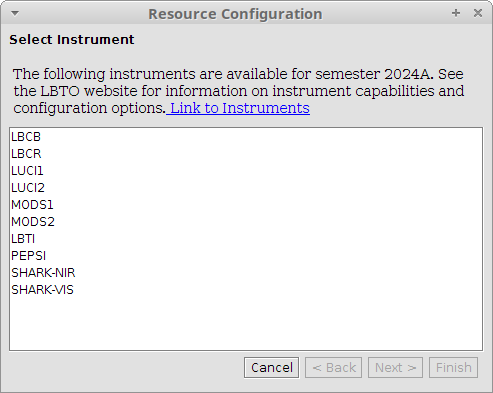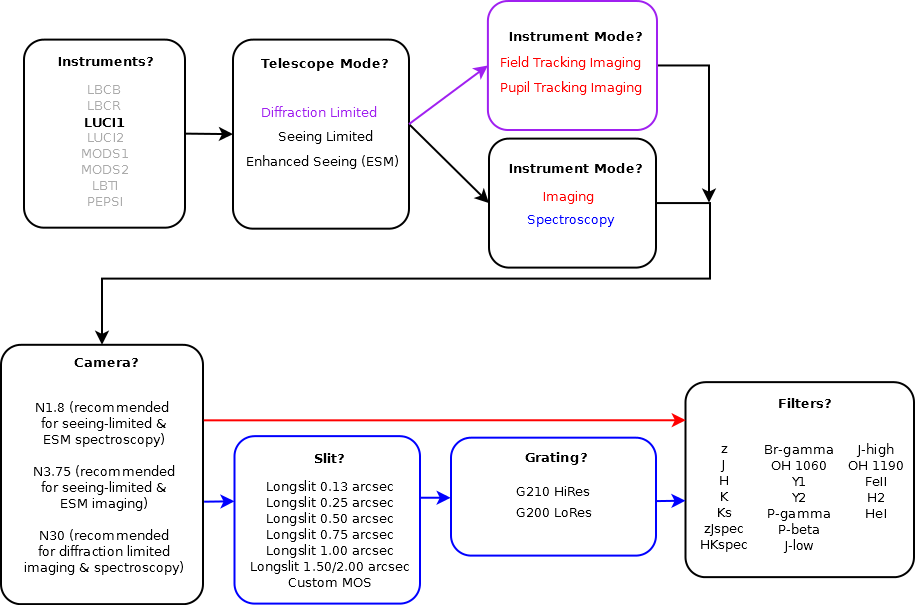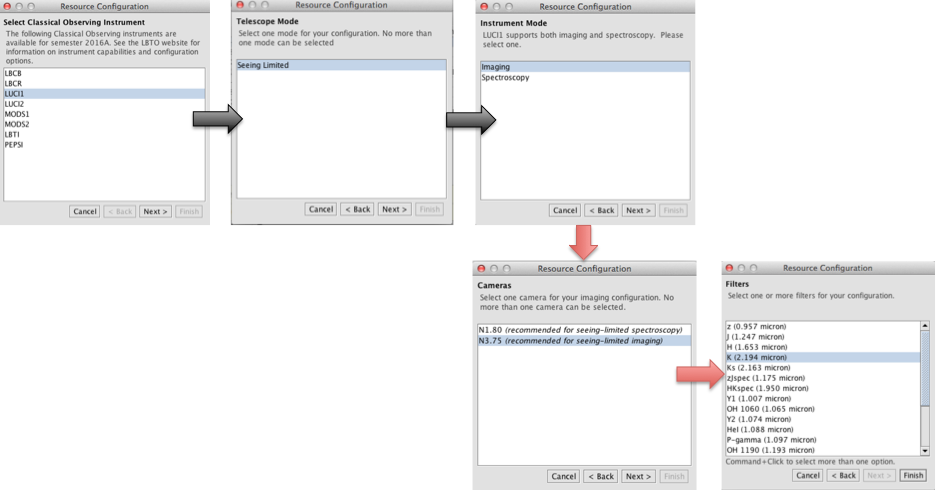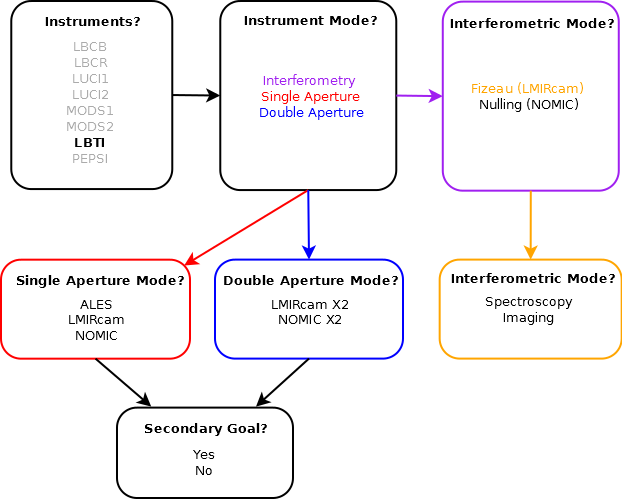Instrument Configuration
As mentioned in the Resources section of the Observation Tab pages, a PI can select the instrument he or she would like to use with the resource configuration tool in the PIT. For facility instruments, (MODS, LUCIs, LBCs, PEPSI) one can also set the observing mode, grating, slits, filters, etc. for each instrument. The wizard will lead the PI through a “decision” tree of modes and their options.
Instrument Selection:
Using the filter wheel icon on the lower left of the Observing Tab, one can bring up the Observing Instrument window. While a PI can specify multiple instruments in a single proposal, the configuration of each instrument must be completed separately. This requires that the user select only one instrument at a time in the configuration manager.

LBCs:
The Large Binocular Cameras are a pair of wide-field optical imagers mounted at the prime focus of the DX (right) and SX (left) sides of the telescope. LBC Red (DX) and LBC Blue (SX) are optimized for different parts of the optical spectrum and have slightly different compliments of filters. The LBCs are often used together in binocular mode, but as mentioned above each observation must be configured separately.
To configure LBCR, choose the instrument from the Main Resource Configuration Selector (shown above) and then choose the filter with which you would like to observe from the LBCR filter configuration:
To configure LBCB, choose the instrument from the Main Resource Configuration Selector and then choose the filter with which you would like to observe from the LBCB filter configuration:
MODS:
MODS1 and MODS2 are a pair of matched low- to medium-resolution Multi-Object Double CCD Spectrographs/Imagers. The MODS are two identical two-channel spectrographs, one for each of the direct f/15 Gregorian foci of the LBT. Each MODS is a seeing-limited spectrograph and imager working in the 320-1100nm wavelength range with a 6×6-arcminute field of view.
To configure MODS1 or MODS2, choose the instrument from the Main Resource Configuration Selector (shown above). You will then be guided through a decision tree that allows you to specify an instrument mode, slit, and/or filter. The Decision Tree for MODS is shown below. The text, boxes, and arrows are color coded to show the flow; so choosing a mode in GREEN in the Instrument Mode Selector will follow the GREEN arrow to the GREEN Slit Selector box.
For example — if a PI chooses MODS1 and “Dual Grating”, the next choice he or she will make is the slit width or custom MOS from the Focal Plane Unit Selector.
If a PI chooses MODS1 and “Dual Imaging” he or she will then specify a blue and then a red filter from the Blue and Red Filter Selector.
LUCI:
LUCI 1 and LUCI2 are a pair of infrared multi-mode instruments. In seeing-limited mode, each has a 4 arc-minute square field-of-view and is capable of long-slit and multi-slit spectroscopy as well as imaging in the near-infrared. For diffraction limited observations imaging is split up into two separate modes. Field Tracking Imaging is used for normal imaging where the instrument rotator is turned on. For Pupil Tracking Imaging the instrument rotator is turned off and the sky rotates across the detector with the parallactic angle. The latter is used for Angular Differential Imaging (ADI).
To configure LUCI1 or LUCI2, choose the instrument from the Main Resource Configuration Selector (shown above). You will then be guided through a decision tree that allows you to specify an instrument mode, slit, and/or filter. The Decision Tree for the LUCIs is shown below, LUCI1 first, followed by LUCI2. The text, boxes, and arrows are color coded to show the flow, where red indicates options for imaging only and blue indicates options for spectroscopy only.
LUCI1:
LUCI2:
For example — if a PI chooses LUCI1, Seeing Limited and “Imaging”, the next choice he or she will make is the camera and then the filters.
If a PI chooses LUCI1, Seeing Limited, and Spectroscopy he or she will then specify a camera, a slit or custom mask, a grating, and a filter.
LBTI:
The Large Binocular Telescope Interferometer (LBTI) is a high spatial resolution, low thermal background instrument making use of both 8.4m apertures of the LBT. It is designed for nulling interferometry using the 14.4m (center-to-center) baseline of the LBT, Fizeau imaging interferometry using the 22.8m (edge-to-edge) effective aperture of the LBT, and adaptive optics imaging using the two apertures separately.
To configure LBTI, choose the instrument from the Main Resource Configuration Selector (shown above). You will then be guided through a decision tree that allows you to specify an instrument mode and configuration.
For example — if a PI chooses adaptive optics imaging with both apertures, the next choice he or she will make is the camera and then whether NOMIC/LMIRcam should be used for a secondary goal or not.
PEPSI:
PEPSI is a spectrograph located on a 2m x 6m optical table in the telescope pier. It receives light from the polarimeters and permanent focus stations via 45m long fibres, coupled with image slicers. The polarimetric mode provides a resolution of 120.000, while resolutions of 50.000, 130.000, and 250000 can be obtained with the permanent focus stations. The entire spectral range from 383 to 906.7nm can be covered in three exposures.
To configure PEPSI, choose the instrument from the Main Resource Configuration Selector (shown above) and choose the fibre and then the blue and red cross-disperser with which you would like to observe.












